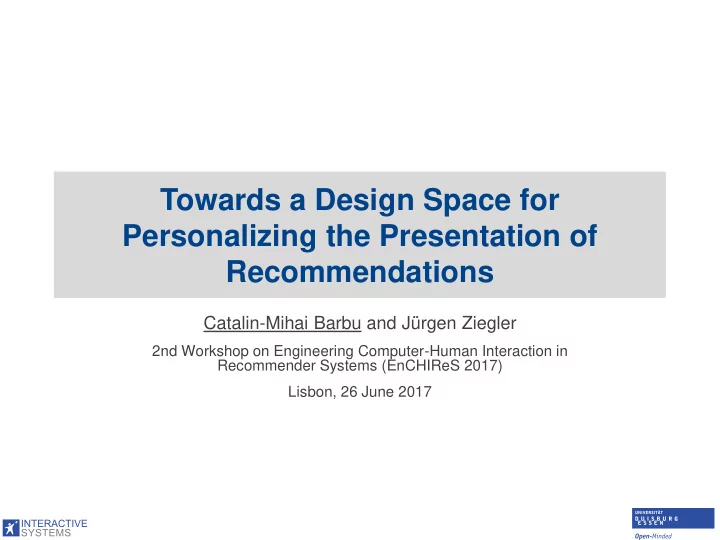

Towards a Design Space for Personalizing the Presentation of Recommendations Catalin-Mihai Barbu and Jürgen Ziegler 2nd Workshop on Engineering Computer-Human Interaction in Recommender Systems (EnCHIReS 2017) Lisbon, 26 June 2017
Recommender Systems ▪ Information systems that match users with items they might find interesting ▪ Several types – Content-based – Collaborative Filtering (CF) – Knowledge-based – Hybrid ▪ Mature algorithms
Personalization “A process of collecting and using personal information to uniquely tailor products, content and services to an individual ” (Tuzhilin, 2000)
Why Personalize at All? ▪ Cater to different tastes , interests , and preferences ▪ Simplify user experience ▪ Support users’ decision making ▪ Increase trust in the recommended items (hopefully) Recommendations are only as good as users perceive them to be (perceived vs. objective accuracy)
Personalizing the Presentation of Recommendations ▪ Exploit user profile to identify important attributes – Stated preferences (reviews, ratings) – Interactions (applied filters, discarded options) ▪ Adapt presentation to suit the user’s needs – E.g., personalized summaries
Overview of Design Space
Design Space Dimensions: Modality
Design Space Dimensions: Modality ▪ Present information using appropriate modalities Nanou et al. (2010) ▪ Design patterns Cremonesi et al. (2016) ▪ Changing modalities
Design Space Dimensions: Salience
Design Space Dimensions: Salience ▪ Draw users’ attention to important information – Show relevant additional information directly ▪ De-emphasize less important features – Or hide them completely Zhao et al. (2016)
Design Space Dimensions: Comparison Functions
Design Space Dimensions: Comparison Functions ▪ Help users evaluate attribute values across recommendations – Normalize / transform measurement units Pu et al. (2007)
Design Space Dimensions: Interactive Control
Design Space Dimensions: Interactive Control ▪ Provide mechanisms to influence the output – Preference elicitation (e.g., using tags) Loepp et al. (2015)
Design Space Dimensions: Interactive Control ▪ Provide mechanisms to influence the output – Interactive critiquing Donkers et al. (2017)
Design Space Dimensions: Explanations
Design Space Dimensions: Explanations ▪ Facilitate the discovery of supporting evidence – Objective info might be wrong / incomplete – Subjective info might be out of context Vig et al. (2009) Chen et al. (2017)
Design Space Dimensions: Trust Cues
Design Space Dimensions: Trust Cues ▪ Determine the reliability of presented information – Complement item descriptions with objective measurements – Determine credibility of user reviews Yan et al. (2013)
Interactive Mechanisms Goal: Support the user’s decision -making process ▪ Content – Show personalized summaries – Allow users to “zoom” in / out – Manipulate the order in which sections are presented ▪ User profile – Preview effect of changes on the presentation
Evaluation Criteria ▪ Suitability w.r.t. the user’s informational need – Consequences of poor choices – Level of detail – User characteristics
Conclusions & Future Work ▪ Personalizing the presentation of recommendations can lead to increased transparency and control ▪ Proposed dimensions need to be validated empirically ▪ Quality of user data is a limiting factor Thank you! Questions?
References Chen, Y. Interface and interaction design for group and social recommender systems. In Proc. RecSys '11, ACM (2011), 363 – 366. Cremonesi, P., Elahi, M., & Garzotto, F. User interface patterns in recommendation-empowered content intensive multimedia applications. Multimedia Tools and Applications , Springer (2016), 1 – 35. Donkers, T., Loepp, B., & Ziegler, J. Tag-enhanced collaborative filtering for increasing transparency and interactive control. In Proc. UMAP '16 , ACM (2016), 169 – 173. Loepp, B., Herrmanny, K., & Ziegler, J. Blended recommending: Integrating interactive information filtering and algorithmic recommender techniques. In Proc. CHI '15 , ACM (2015), 975 – 984. Nanou, T., Lekakos, G., & Fouskas , K. The effects of recommendations’ presentation on persuasion and satisfaction in a movie recommender system. Multimedia Systems 16 , 4-5 (2010), 219 – 230. Pu, P., & Chen, L. Trust-inspiring explanation interfaces for recommender systems. Knowledge-Based Systems , 20-6 (2007), 542 – 556. Tuzhilin, A. Report on the KDD2000 panel personalization and data mining: Exploring the synergies . ACM SIGKDD Explorations Newsletter , 2-2 (2000), 115 – 116. Vig, J., Sen, S., & Riedl, J. Tagsplanations: explaining recommendations using tags. In Proc. IUI '09 , ACM (2009), 47 – 56. Yan, Z., Liu, C., Niemi, V., & Yu, G. Exploring the impact of trust information visualization on mobile application usage. Personal and ubiquitous computing , 17-6 (2013), 1295 – 1313. Zhao, Q., Chang, S., Harper, F. M., & Konstan, J. A. Gaze prediction for recommender systems. In Proc. RecSys '16, ACM (2016), 131 – 138.
Recommend
More recommend